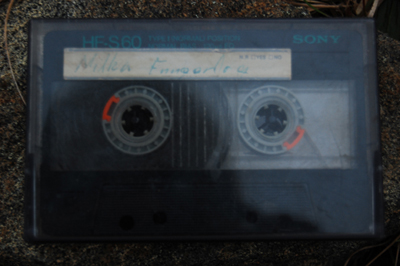Anda’s Tape
Anda’s Tape
i. Drum dancing exists in different forms in Inuit communities across Alaska, Canada, Greenland and Siberia. Through performances, recordings and the threat of its disappearance, the drum has become a symbol of cultural identity, construed as a form of ‘heritage’. This is heritage as a tangible ‘thing’. However for those involved in drum dancing it is less objective and part of a sensory engagement with the world that the dichotomy of tangible and intangible heritage cannot really explain.
The recording presented here is the result of a summer of fieldwork in 2011, spent on the island of Kulusuk just off the coast of East Greenland. I worked with Anda Kuitse, a 60 year old Greenlandic drum dancer, as he listens to a treasured tape cassette recorded in 1962, of his father drum singing. It is a tape that he uses to this day. I was fascinated by how the material technology of the cassette tape expressed a sensory relationship between father, son and drum in the act of listening to playback.
Regarding the sensory experience of heritage in relation to technology, Anda Kuitse engages – through auditory imagination and remembering – in a temperamental dialogue with the cassette tape. In conversations with me he recalled in a fragmentary manner his childhood experiences with his father and the ‘good old days’ when the elderly people were still alive. When sad, he listens to the tape and when the tape speaks Anda enters into dialogue with it. The tape seems to offer the impossible promise of time travel but in always poignantly failing to deliver becomes a sad reminder that what is always there on the tape is a presence of absence.
Because of this strong perceptual relationship between the drum dancer Anda and the drum dancing tape, the latter transforms from being a strong vessel and protector of heritage into a tremendously fragile object that is in need of protection itself. It is as if the spool of the tape signals the very crucial connection to Anda’s father and the community’s ancestors and if broken would result in separation and exile.
 The central argument, which the sound recordings helps bring to light, is that we can understand heritage as an experience of listening bound up with the relationship between technology and sound. Furthermore it also questions the very notion of heritage, what it is made up of and how it comes into being.
The central argument, which the sound recordings helps bring to light, is that we can understand heritage as an experience of listening bound up with the relationship between technology and sound. Furthermore it also questions the very notion of heritage, what it is made up of and how it comes into being.
ii. The two recordings can be listened to independently, although I recommend listening to them in the order they are placed in here.
1. The recording
Greenlandic Radio recorded Anda Kuitse’s father and a small handful of other Inuit, performing drum singing. Years later, after the death of his father, Anda Kuitse was given a cassette tape containing a recording of the broadcast of this recording, and it is from listening to this tape in the living room of his yellow wooden house and remembering past moves and sounds, that he taught himself the drum rhythms and drum songs. During my fieldwork I digitized the recording by playing the cassette tape on a stereo and recording the playback, all of this taking place in the living room of Anda’s neighbor’s house, in which I and the neighbor’s son were present. Finally this recording entered an editing program. Thus, the different recorded events unfolding in different times and spaces are acoustically present in the digitized recording.
2. Set in the living room of Anda’s wooden house, the sound piece is based on recordings of Anda talking about memories of previous times. As a mosaic of different recordings, this sound piece was designed to convey the sense of place and of the emotions involved in the layering, recording and remembering of drum dancing. As such the listener is introduced to the room, the surroundings, Anda and Anda’s tape reveal themselves and “…come into being solely within these changing fields of mixed emotions, associations and auditory flows,” (Jackson 2004).
3. Bibliography / Phonography – related works
Beckett, S. (1959/1965). Krapp’s Last Tape: and, Embers. London, Faber and Faber.
Byrne, D. (2009). A critique of unfeeling heritage. Intangible Heritage. L. Smith and N. Akagawa. London and New York, Routledge.
Casey, E. S. (1987). Remembering. Bloomington and Indianapolis, Indiana University Press.
Jackson, M. (2004). “Reflections on Copenhagen: Listening with Steve.” (sensatejournal.com/2011/03/author-3-title-of-the-article-in-sensate/)
Lucier, A. (1980). I am Sitting in a Room ( www.lovely.com/titles/cd1013.html).
Postlewait, T. (1978). “Self-performing Voices: Mind, Memory, and Time in Samuel Beckett’s Drama”. Twentieth Century Literature 24 (4): 473-491.
Schafer, M. R. (1977/1994). The Soundscape: Our Sonic Environment and the Tuning of the World. Rochester, VT, Destiny Books.
Biography of recordist
Dorthe Bækby Olesen holds an MA degree in Visual Anthropology with a specialization in Documentary and Sensory Media (2011) from the University of Manchester. She currently lives in Aarhus, Denmark, from where she received a BA in Social Anthropology (2008). She works as an independent filmmaker and freelance visual anthropologist.
Thanks
The tape recordings presented here are with the kind permission of Anda Kuitse whose co-operation was invaluable and the inspiration for this project.
